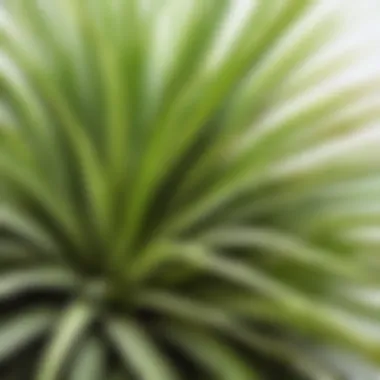Exploring Fresh Air Plants: Care and Benefits Guide


Intro
Fresh air plants, often referred to as indoor greenery or air-purifying plants, have made a splash in home and office decor. Their appeal lies not only in their aesthetic charm but also in their ability to improve air quality and boost well-being. In a world increasingly dominated by screens and artificial environments, these plants serve as a breath of fresh air—quite literally.
This article aims to dig into the fascinating features of various fresh air plants, the nuances of their care, and the multitude of benefits they bring to our living spaces. Whether you're a seasoned plant enthusiast or a newcomer looking to add some life to your surroundings, this comprehensive guide will provide invaluable insights into how to select, maintain, and appreciate these little green wonders.
Let's embark on this journey to explore the lush realm of fresh air plants, their unique characteristics, and how they can enhance both your living and workspace. More than just decorative additions, these plants have a significant role in design trends and human well-being, providing much more than meets the eye.
Prologue to Fresh Air Plants
Fresh air plants have become a growing conversation piece everywhere from trendy coffee shops to private homes. They not only add a splash of greenery but also play a crucial role in enhancing the overall ambience of any space. The significance of incorporating these plants in our living and working environments stretches far beyond aesthetics. In fact, fresh air plants are often called nature's air purifiers, drawing everyday pollutants out of the air and enriching our surroundings with oxygen. They invite more than just visual appeal; they usher in emotional and psychological benefits.
Definition and Overview
Fresh air plants, often referred to as indoor plants or air-purifying plants, are species that thrive in household environments. This includes everything from common varieties like the Peace Lily to rarer finds such as the Tillandsia Xerographica. What sets these plants apart is their extraordinary ability to filter toxins from the air.
Most fresh air plants prefer low to moderate sunlight, making them ideal companions for those who may not have a green thumb. For instance, the Snake Plant boasts a resilience that allows it to tolerate neglect. When we delve deeper, we discover that these plants are not just decorative items; they play a vital role in improving indoor air quality, reducing stress levels, and enhancing focus.
Historical Significance
The journey of fresh air plants isn't just a modern trend but has roots that date back to ancient civilizations. In Chinese culture, plants were integral to Feng Shui practices, believed to cultivate a balance of energies within homes. The Egyptians were notorious for their use of greenery to enliven spaces and symbolize life and growth. As far back as the Middle Ages, herbs and flowering plants adorned monastic gardens, indicating a blend of beauty and utility.
With the rise of urban living, the fresh air plant movement gained momentum during the latter half of the twentieth century. DIY gardening and the houseplant revival in the 1970s brought them into homes, leading to the popularity we see today. The teachings of influential figures, such as botanist Dr. B.C. Wolverton, who conducted pioneering research on the indoor plant's effect on air quality, have further fueled interest. As the world confronts increasing pollution levels, revisiting these historical practices becomes ever more relevant.
"The presence of plants not only brightens our homes but also helps in maintaining our well-being."
Clearly, the significance of fresh air plants transcends mere decoration. Understanding their definition and history lays a splendid foundation for exploring the various species available as well as the benefits they offer.
Types of Fresh Air Plants
When delving into the realm of fresh air plants, understanding the various types available is crucial. Each variety offers its own set of characteristics, benefits, and aesthetic contributions to indoor as well as outdoor spaces. Knowing these details not only enhances appreciation for these plants but also aids in selecting those best suited for individual environments. This section covers both common varieties and rare, exotic options, filling the reader's toolkit with invaluable knowledge.
Common Varieties
Peace Lily
The Peace Lily is often praised for its elegant white blooms, making it an attractive addition to any indoor space. Its capacity to thrive in low-light conditions is a significant feature, appealing to those who may not have ample sunlight streaming through their windows. Remarkably, the Peace Lily contributes to air purification by filtering out harmful toxins like formaldehyde and benzene.
However, it is crucial to note that while the plant is relatively easy to care for, it does require careful attention to watering. Signs of wilting suggest that it might need more water, but overwatering can lead to root rot. Thus, finding the balance is the key. Overall, its ability to enhance indoor aesthetics and clean the air makes it a beneficial choice for anyone looking to uplift their space.
Snake Plant
Commonly referred to as "Mother-in-Law's Tongue," the Snake Plant boasts tall, stiff leaves with striking patterns of green and yellow. As a drought-resistant plant, it doesn't need frequent watering, making it ideal for those who often forget about their green companions. The Snake Plant stands out as it releases oxygen at night, a unique trait that sets it apart from most plants.
Though it's highly resilient, its sharp leaves can be a hazard in small environments, so careful placement is advised. Its forgiving nature and air-purifying abilities make it a popular choice for both beginners and seasoned plant enthusiasts.
Spider Plant
Spider Plants are well-known for their charming arching leaves that can produce "baby" plants, or pups, which hang down like little green spiders. They adapt well to various lighting conditions, but they flourish in bright, indirect light, showcasing their vibrant foliage.
Additionally, studies have shown that Spider Plants can effectively remove pollutants like carbon monoxide and formaldehyde from the air. Despite their generally low maintenance, these plants can be sensitive to water quality, so using filtered or distilled water may be beneficial. This mix of appeal and practicality renders the Spider Plant a cherished addition in homes with families or pets.
Bamboo Palm
The Bamboo Palm exudes a tropical vibe with its slender, arching fronds that instantly infuse any room with life. Recognized for its ability to purify indoor air, it effectively filters common toxins, improving overall air quality significantly.
This palm prefers warmer, humid climates, reflecting its tropical origins. Consequently, it thrives in settings that mimic this environment, such as bathrooms or kitchens. However, its height can be a double-edged sword; while it makes a bold statement, it also requires adequate vertical space. Overall, its grandeur combined with air-purifying qualities makes the Bamboo Palm an appealing choice for those who want a touch of the outdoors within their four walls.
Rare and Exotic Options
Air Plants
Air Plants, or Tillandsia, are unique as they don’t require soil at all. They can absorb moisture and nutrients through their leaves directly from the air, which makes them quite fascinating. Their versatility is striking; one can hang them in creative arrangements, mount them on driftwood, or simply place them in glass terrariums.
While they are easier to care for in some aspects, they do require regular misting or soaking to remain healthy. Their ability to adapt to various environments makes them an alluring choice, especially for those who appreciate creativity in their gardening endeavors.
Tillandsia Xerographica
This specific variety of Air Plant is well-regarded for its impressive, sculptural appearance, boasting wide, silvery leaves that spiral inward. The Tillandsia Xerographica's striking form not only makes it a conversation starter but also an eye-catching piece that enhances any decor.


Much like its cousins, it thrives in low-maintenance conditions, as long as it receives adequate air circulation and light. However, they are slightly more sensitive to humidity levels, so understanding their needs in a household setting is essential. With its aesthetic appeal and minimal care requirements, this plant is an excellent choice for those seeking to add a distinctive flair to their living space.
Monkey Grass
Though often considered a ground cover in outdoor landscaping, Monkey Grass (or Liriope) also finds its place among indoor plants. Its tall, grass-like leaves bring a unique texture to indoor arrangements and can thrive even in low-light situations.
One of its remarkable characteristics is its resilience; once established, it can withstand a variety of conditions, including drought. However, this plant is less effective in air purification compared to other varieties mentioned earlier. Still, it offers an exotic touch and a sense of greenery, appealing to plant lovers seeking diversity in their indoor gardens.
"Choosing the right plants for your space can transform not just the atmosphere but also your well-being. It’s a journey worth embarking on, one leaf at a time."
In summary, exploring types of fresh air plants enables individuals to make informed choices that suit their environments and lifestyles. These plants not only beautify spaces but also provide numerous benefits, from air purification to emotional well-being.
Benefits of Fresh Air Plants
Understanding the role of fresh air plants is a crucial part of this comprehensive guide. Among the various features these plants possess, their benefits extend beyond mere aesthetics. They contribute significantly to enhancing our environments, both physically and psychologically. In a world increasingly filled with electronic gadgets and urban living clutter, fresh air plants offer an oasis of calm and revitalization.
Air Quality Improvement
Fresh air plants are efficient air purifiers. They naturally filter harmful substances from the air, making your living space healthier. Common indoor pollutants like formaldehyde, benzene, and carbon monoxide can be hazardous to your well-being. A notable example is the Peace Lily. This plant not only blooms beautifully but has also shown the ability to absorb these toxic elements, thereby improving indoor air quality.
According to various studies, including reports from reputable sources like Wikipedia, plants like the Snake Plant and Bamboo Palm also lend a hand in detoxifying the air. Such plants absorb gases, and in return, they release oxygen. This exchange in indoor environments can lead to a notable reduction of illness-related symptoms, creating a breathable atmosphere that fosters well-being.
Moreover, plants also enhance humidity levels. When plants undergo the process of transpiration, they release moisture into the air. This can be particularly beneficial during the dry months. Higher humidity levels not only make the air feel cooler but can also decrease the likelihood of respiratory issues. In fact, a study conducted by the Journal of Environmental Management links indoor plants to an increase in overall air quality, making it imperative to consider incorporating them into various spaces.
Psychological Enhancements
The psychological benefits of fresh air plants have been well documented. They bring about a sense of tranquility and can be remarkably effective in reducing stress levels. When surrounded by greenery, individuals often experience improved mental clarity and focus. This is not just anecdotal; research published on platforms like Britannica.com points towards a positive correlation between indoor plants and mood elevation.
Consider the act of caring for plants; it can serve as a mindful activity that helps ground individuals in the present moment. Tending to a Peace Lily or a Spider Plant can provide a simple yet effective escape from the hustle and bustle of daily life. It's akin to having a small, breathing piece of nature within your home that reminds you of the importance of rest and rejuvenation.
Additionally, incorporating plants into workspaces has shown to boost productivity. They help reduce fatigue and increase job satisfaction. One research paper indicated that workers in offices with plants reported higher well-being scores and a greater sense of job satisfaction. By investing in these green companions, one can experience not just visual appeal but also tangible improvements in mental health.
"The more your workplace feels alive, the more alive you feel at your workplace."
In short, the benefits of fresh air plants are multifaceted. They don’t just sit pretty; they play a pivotal role in enhancing our quality of life. The combination of cleaner air and psychological uplift brings deeper meaning to the concept of nurturing life within our own spaces. As the world shifts towards a more sustainable and health-conscious approach, understanding these benefits gives us both a reason and a way to bring nature back into our daily lives.
Care Techniques for Fresh Air Plants
Taking care of fresh air plants goes beyond simply watering them now and then. Proper care techniques can vastly influence their health, growth, and overall contribution to your indoor environment. Understanding how these plants thrive brings immense benefits, from improving air quality to enhancing the aesthetic of your space. By mastering care techniques, you not only help these plants flourish but also create a leafy haven that can have a positive impact on your mental and emotional well-being.
Lighting Requirements
Light is perhaps one of the most vital elements for the success of fresh air plants. Understanding the differences between direct and indirect sunlight can help you pinpoint the ideal spots for your leafy friends to thrive.
Direct vs Indirect Sunlight
Direct sunlight refers to unfiltered sun that reaches the plant directly. On the contrary, indirect sunlight is when the sun’s rays are diffused or reflected, reducing intensity. Many fresh air plants, such as the snake plant, enjoy the moderate embrace of indirect sunlight. This is beneficial because it prevents leaf burn, a common affliction for those plants that receive too much direct sun. Still, some plants like succulents can soak up that strong sun, thriving under it.
A key difference of indirect sunlight is its relaxing quality. It allows for a steady growth pace without the drama of sunburn. Just make sure to keep an eye on them; if the leaves turn pale, that can be a sign they are longing for a bit more sunshine.
Artificial Lighting Solutions
Artificial lighting can be a game changer for those who lack access to ample natural light. Artificial lights, like LED grow lights, simulate the sun’s rays and are highly effective for indoor plants. They offer flexibility, making it easy to place plants in almost any room regardless of window placement. This is particularly favorable for urban dwellers or anyone with a less-than-ideal lighting situation.
However, it’s essential to choose the right spectrum; plants typically thrive under both blue and red wavelengths. Too much artificial light can lead to instability, with plants stretching toward light sources creating an unkempt look. But properly managed, artificial lighting opens new frontiers for plant care.
Watering Practices
Water is a delicate balance act. Knowing how much to give can be the difference between a lush, thriving plant and a shriveled mess.
Signs of Overwatering
Overwatering is often considered the silent killer of houseplants. Symptoms usually include yellowing leaves or a mushy stem. This showcases just how detrimental too much water can be. Understanding this aspect of watering is paramount in preventing root rot, a condition that can swiftly take your beloved plant from vibrant to dead.
Finding the right balance is crucial. Allow the top layer of soil to dry out before watering again, but keep a close eye on the leaves. They can communicate more than you’d think.
Optimal Watering Frequency
Establishing an optimal watering frequency is about observing and adapting. Each plant has its own thirst level. Generally, during the growing season, watering once a week works well for many varieties. However, in winter, when growth may slow down, this might cut down to once every two weeks.


A unique feature of optimal watering is that it encourages root growth. When plants receive just the right amount, their roots will reach for moisture, stimulating healthy development.
Fertilization Strategies
Fertilization can dramatically enhance plant health, but the wrong type or amount can easily cause trouble.
Types of Fertilizers
Fertilizers generally fall into two categories: organic and synthetic. Organic options—like compost or fish emulsion—tend to gradually release nutrients, promoting a healthier soil biome. On the other hand, synthetic fertilizers deliver quick nutrients but may cause a buildup of salts if not used correctly.
This gives organic fertilizers a well-deserved edge. They represent a gentler approach, minimizing risks of over-fertilization that could stress the plant.
Feeding Schedule
A feeding schedule dictates when and how often you should apply fertilizers. Regularly feeding during the growing season, typically in spring and summer, is essential. But fall and winter usually call for a pause since many plants enter dormancy.
Having a consistent feeding schedule not only supports growth but also keeps the plant vibrant. By staying disciplined with it, you’ll reap the rewards of robust, lush foliage.
For anyone nurturing fresh air plants, optimizing care techniques truly makes a world of difference. It transforms what seems like upkeep into artful engagement, enhancing not just the well-being of plants but your nurturing skills as well.
Integrating Fresh Air Plants into Homes
Integrating fresh air plants into homes goes beyond aesthetics; it's an important step towards creating a healthier living environment. The ability of these plants to purify air and enhance mood cannot be overstated. They serve as both a functional and decorative element in interior design. Each type of plant brings unique qualities, and choosing the right placement or arrangement maximizes their benefits. This section basically focuses on how to effectively incorporate these plants into various living spaces, ensuring their contributions to well-being and design coherence.
Design Considerations
Indoor vs Outdoor Placement
The decision between indoor and outdoor placement of fresh air plants often hinges on light availability and space configuration. Indoor plants like the Snake Plant or Peace Lily thrive in low light, making them suitable for almost any indoor space. Outdoor placement, however, may require a bit more thought concerning climate and sun exposure.
One key characteristic of indoor plants is their adaptability. They fit snugly into small spaces, like offices or apartments, where outdoor options might not be feasible. Benefits here include heightened air quality, especially in confined spaces. On the flip side, outdoor plants can grow larger and often receive beneficial natural light, contributing with vigorous growth.
Some may argue that outdoor plants could be susceptible to environmental factors which indoor plants aren't. Unique features like potted arrangements or hanging baskets can create a vibrant outdoor display while still maintaining manageability.
Creating Plant Corners
Creating plant corners provides an opportunity to establish a dedicated botanical space within any room. This specific aspect taps into the visual impact of plants, clustering them in a way that highlights their beauty and enhances overall aesthetics. It's a popular approach due to its knack for transforming dull corners into lively focal points.
A key characteristic of such arrangements is the layering of plants. Taller species can stand on the back row, while shorter ones can sit in front, creating dimension. This method caters to both casual observers and plant enthusiasts, making it a universally accessible choice.
However, one must keep in mind that a disadvantage could arise when it comes to care; maintaining multiple plants in a specific area demands consistent attention to ensure none outshine or overshadow the others.
Thematic Arrangements
Minimalist Themes
Minimalist themes offer a fresh take on the integration of plants, emphasizing simplicity and clean lines while celebrating the beauty of nature. A key characteristic of this design is its restraint – fewer plants are hedged around ample space, highlighting each one's individual contribution.
This approach is beneficial for those who appreciate subtle elegance in their decor. The unique feature here lies in the selection of plants such as the ZZ Plant or a Monstera; these elements can stand out without clashing with minimal aesthetics. The downside might be that it requires a careful selection to avoid over-cluttering a sparse style.
Bohemian Styles
Bohemian styles, on the other hand, thrive on diversity and vibrancy. This specific aspect celebrates eclectic plant groupings with differing sizes, textures, and colors. A key characteristic of this theme is an embrace of the unconventional, where pots can vary from terracotta to ceramic.
This inward freedom enables a lush display, which can be an invigorating experience for many. The unique feature of a Bohemian arrangement is the ability to mix non-traditional elements like hanging plants with floor-based ones or trailing vines flowing down shelves. The potential downside could include a busy appearance, which might overwhelm some eyes.
Modern Aesthetics
In contrast to other styles, modern aesthetics push for clean yet impactful plant arrangements. This specific aspect focuses on streamlined designs that feature select plants against a backdrop of refined furniture and decor. Popular choices include tall, structured plants, like Fiddle Leaf Figs, providing a striking vertical element.
A key characteristic of modern arrangements is the careful balance, ensuring that plants serve as part of a bigger design picture. The unique feature resides in choosing pots that harmonize with existing decor while allowing greenery to shine through. However, one must be cautious about the risk of too much minimalism, which can sometimes lead to a stark or cold feeling in a space.
"Plants not only enhance our environments aesthetically, but they also foster emotional well-being and a breathable atmosphere."
As one adapts their living space with fresh air plants, considering these various styles and placements is crucial in achieving the desired effect without compromising on care and maintenance.
Common Challenges in Care
Caring for fresh air plants can feel like trying to hit a moving target; there are unique challenges that one might face along the way. Recognizing these obstacles is critical for ensuring the longevity and health of these green companions. Just like any living entity, these plants have their preferences and demands. Addressing common issues—like pests and diseases—can save you from a whole heap of trouble later down the line. Moreover, understanding these challenges can equip you with the knowledge to foster a nurturing environment that helps your plants thrive.


Pest Management
When it comes to maintaining fresh air plants, pest management is akin to keeping a watchful eye on the horizon before a storm rolls in. Diseases can often sneak up on even the most experienced plant caretakers, and certain critters can wreak havoc before you can say "plant rescue." Identifying pests early can make all the difference in keeping your plants vibrant and healthy.
Aphids
Aphids often resemble tiny specks of green, yellow, or black, and they can be quite the nuisance. These critters tend to gather on the tender shoots and leaves of your plants, sucking the sap like it's their morning coffee. In doing so, aphids can weaken your plants, leading to stunted growth and yellowing leaves.
What's noteworthy about aphids is their rapid reproduction rate; a couple of them can quickly multiply and turn into an infestation before you notice. They can also attract ants, creating a messy nest of problems.
Strategies for dealing with aphids include using a water spray to knock them off or introducing natural predators, like ladybugs. Taking action sooner rather than later can pay dividends when it comes to plant health.
Mealybugs
If you think aphids are troublesome, mealybugs may take the cake. These little white clumps of fluff are often mistaken for cotton or mold, but they’re actually colonies of mealybugs feeding on your plant’s sap. They can cause damage similar to aphids, leading to yellow leaves and poor growth.
One defining feature is their waxy coating, which helps them evade some insecticides. They often congregate in hidden spots, like leaf joints or under leaves, so regular inspections are key.
For management, a cotton swab dipped in alcohol can do wonders to wipe them away. While they might not be the most pleasant guests in your home, with vigilance, you can keep them at bay.
Spider Mites
Spider mites are not technically insects; they belong to the arachnid family, which means they are closely related to spiders. These tiny pests can be all but invisible until their presence is suspected. They often create fine webbing between leaves, which can be alarming at first.
What sets spider mites apart is their ability to thrive even in dry environments, making them a persistent challenge during hotter months. These pests feed by piercing plant cells and sucking out the contents, which can lead to stippling or discoloration.
To combat spider mites, humidity is your ally—keeping the air moist can deter them. Regular misting can also keep the little buggers from becoming a problem.
Disease Prevention
While pests can feel like a pressing issue, plant diseases are equally menacing in the long term. Knowledge of how to spot and prevent diseases is indispensable, as virulent strains can quickly lead to catastrophic outcomes. Just as with pests, early detection and prevention are your best defenses in safeguarding your green space.
Mold Growth
Mold growth can be a bit like that uninvited guest who just won't leave—once it settles in, it can be a pain to remove. Mold typically manifests in high humidity or poor air circulation. It often shows itself as a fuzzy coating on the soil or leaves. Not only can it be unsightly, but mold can also hinder your plants’ ability to absorb nutrients.
One way to combat this issue is by ensuring proper drainage and not overwatering your plants. Elevating pots and using well-draining soil can help prevent mold from taking root. It's a matter of providing a clean and airy environment for your plants.
Fungal Infection
Fungal infections can sometimes feel like a dark cloud hanging over your plant collection, especially when they develop due to poor care. These infections can take root in a range of conditions, often accentuated by excessive moisture and low light. Identifying a fungal infection early can help you intervene before it spirals out of control.
One unique feature of fungal infections is their potential to spread rapidly, especially if conditions remain conducive. This means an infected plant can jeopardize its neighbors. Keeping good airflow around your plants, avoiding wet foliage and maintaining cleanliness in your potting area can go a long way in preventing these infections.
In summary, being proactive about care challenges, both pests and diseases, contributes significantly to a plant's overall well-being. It's often said that "an ounce of prevention is worth a pound of cure." In the world of fresh air plants, this couldn't hold more truth. Understanding the adversaries you face allows you not just to endure but also to thrive in your gardening journey.
Environmental Impact of Fresh Air Plants
Fresh air plants, a category that embraces a variety of species, play a crucial role in promoting healthier environments. The positive environmental impact of these plants extends beyond interior decor; they contribute meaningfully to air quality, urban greening, and biodiversity preservation. With the increase in urbanization, understanding how these plants influence our surroundings becomes paramount.
Sustainable Practices
Incorporating fresh air plants into our living spaces is not just about aesthetics; it's about sustainability too. These plants contribute significantly to ecological balance by absorbing carbon dioxide and releasing oxygen. They can act as natural air purifiers, eliminating toxins and improving the air we breathe.
To maximize this benefit, individuals can adopt several sustainable practices in their care routines:
- Organic fertilization: Opt for organic fertilizers over chemical ones. This supports soil health and protects local ecosystems.
- Water conservation: Employ systems like drip irrigation or rainwater harvesting. This minimizes waste.
- Local sourcing: Whenever possible, acquire plants from local nurseries to reduce transportation emissions.
Implementing these practices encourages a greener approach to plant care, reinforcing a sense of responsibility towards our environment.
Contribution to Urban Ecology
Fresh air plants are not merely personal treasures in our homes; they are essential players in urban ecology. With most people living in cities today, utilizing fresh air plants can help to address several urban challenges, such as:
- Biodiversity enhancement: Incorporating various species of fresh air plants supports local flora and fauna, which in turn enhances biodiversity.
- Urban heat island mitigation: Plants can help lower air temperatures by releasing moisture and providing shade, combating the heat generated by city structures.
- Stormwater management: Plants can aid in absorbing rainwater, reducing runoff and the risk of flooding in urban settings.
As cities continue to expand, the role of fresh air plants as contributors to urban ecology becomes increasingly significant. They offer solutions that align with contemporary challenges, shaping healthier neighborhoods and reinforcing the importance of plant life in our ecosystems.
"Plants provide a silent, yet powerful, service to urban environments—cleaning air and offering a sanctuary of biodiversity."
These insights into the environmental impact of fresh air plants illuminate their multifaceted roles beyond decor. By integrating these plants into our daily lives, we not only enhance our personal spaces but also invest in the ecological health of our communities.
Epilogue
The conclusion ties together the various threads discussed throughout the article, highlighting the significance of fresh air plants not only for enhancing indoor environments but also for revitalizing well-being. Their ability to purify air, combined with their aesthetic appeal, positions them as both practical and stylish choices for modern living.
Recap of Key Points
In summary, a few essential points stand out:
- Diverse Varieties: There is a wide array of fresh air plants, each with its own unique traits and care requirements. From common varieties like Peace Lily and Snake Plant to rare options such as Tillandsia Xerographica, enthusiasts have ample choices.
- Impact on Well-being: Air quality improvement thanks to these plants can significantly enhance mental clarity and create a more serene ambiance at home or work. The psychological benefits of having greenery around are backed by research.
- Care and Integration: Understanding how to properly care for these plants and incorporating them into your decor can lead to thriving, vibrant plants that contribute positively to your living spaces.
- Environmental Contributions: Fresh air plants play a pivotal role in sustainability efforts and urban ecology by helping to offset carbon footprints and support local biodiversity.
Future Trends in Air Plants
Looking ahead, the trend for integrating fresh air plants into everyday life seems to be on the rise. Not only are these plants becoming staples in home decor, but technological advancements also promise to change how we cultivate plants indoors.
- Smart Gardening: The rise of smart pots and automated gardening systems shows great potential. These gadgets can monitor moisture levels and ensure optimum growth conditions without requiring constant attention from the user.
- Urban Green Spaces: As urban areas become denser, there's an increasing push for vertical gardens and urban farming. Fresh air plants lend themselves well to these environments, as they can thrive in smaller spaces and need less direct sunlight.
- Focus on Mental Health: As awareness about mental health continues to grow, more individuals and organizations are turning to nature-based solutions. Fresh air plants are poised to be at the forefront, used in corporate offices and healthcare facilities to foster relaxation and reduce stress.
Ultimately, the journey with fresh air plants is as enriching as the benefits they offer, making them more than just decorative items—their role is evolving, and their importance is becoming clearer.
"Bringing nature indoors is not merely a trend; it is a lifestyle that impacts our well-being and the environment positively."
This comprehensive understanding of fresh air plants empowers both novices and seasoned enthusiasts to leverage their benefits to the fullest.







